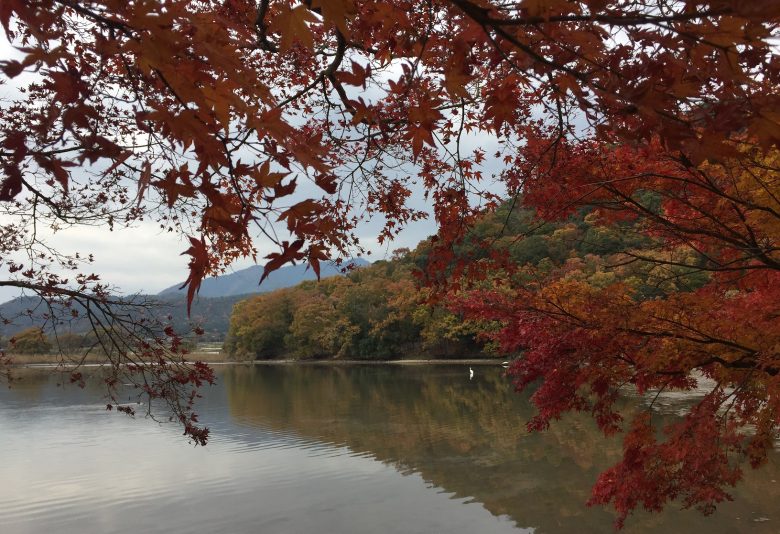
Living in Japan’s traditions: Momiji-gari
In our previous Sakura Tips we have seen how the connection with nature is very much present while living in Japan. Even at many (if not almost all) of our share house, guest house and apartment units there is a park close by, and others, such as some of our large vacation rentals, have their own garden. It is normal then to have aspects of nature blend into the Japanese life and custom. Most people are already aware of the “hanami”, or cherry blossoms viewing in spring, but another very popular season is the “momiji” or “kōyō”.
 Momiji at our KYOTO R machiya house garden
Momiji at our KYOTO R machiya house garden
Momiji refers to the autumn leaves and how their varied red, yellow, orange and brown colors decorate the natural landscape, whether it be the mountains of Kyoto, the large parks in Tokyo or the coastal scenery of Izu. As there is a word for cherry blossoms viewing, there is a word for autumn leaves viewing and that is “momiji-gari” (紅葉狩り).
Literally speaking momiji-gari means “hunting autumn leaves” with “momiji” refering to the autumn leaves and “gari” (from the verb “karu”, meaning to hunt, usually used for hunting animals but also used for flowers, mushrooms, etc.). As with all Japanese words, and specially with seasonal words, there is a history behind it and why it came to be named like this.

The first appearance of this word happens to be recorded in the historical Man’yōshū, a compilation of the oldest Japanese poetry dating all the way back to the 8th century during the Nara period. The word “momiji” actually seems to derive from “momiidzu” (揉み出づ) as describing the process of dying with “momi” (揉み) being “to rub” and “idzu” (出づ) being “to come out”. The evolution to the kanji 紅葉 seems rather complex since it can also be read as “kōyō”, which matches with another related word that appears in the Man’yōshū poetry compilation, appearing as 黄葉. The reason seems to be that when referring to the maple tree it is used as “momiji”, but when refering to the change in the leaves then “kōyō” is sued.
As for the verb “karu”, as we saw previously, it was used for hunting down large animals. As time evolved it started being used for smaller animals and birds, and thereafter for fruits and other elements of nature. Nowadays it is common to hear of “ichigo-gari” (starwberry picking) or “budō-gari” (grapes picking) as well. However, no one picks autumn leaves when going to view them (unless they fall to the ground), so how did it go from hunting or picking to simply viewing? The answer lies in the noble groups lifestyle. It appears that actually the branch of the tree was plucked and viewed from a close distance. This is nowadays considered bad manners, of course, as it is with the cherry blossoms viewing. Another explanation seems to be that walking was consider indecent for the nobility to go around walking, so the word for hunting seemed to provide a more meaningful and appealing reason for their outgoing.

As we saw, the origin of “momiji” appeared around the Nara period, and although it was custom to enjoy viewing the cherry blossoms and the wisteria during the peak of their seasons, the autumn leaves were not a major seasonal attraction yet. The reason may have been because it was possible to grow the aforementioned flower trees at home, but for the autumn leaves it was particularly necessary to go outdoors, specially into the mountains, where the great variety of colors could be appreciated. Also, the whole meaning of the leaves in autumn were that of the transience of life, the approach to winter and the loneliness this brings, which was not much of a happy gathering for most. However, this changed drastically during the Edo period (1603-1868).
During the middle years of the Edo period, the great pilgrimage to Ise Grand Shrine (Isejingu), also known as “Okagemairi”, took place and with it the large popularity of traveling within Japan. From this travel explosion one particular work piece made the beauty of momiji very popular, the “Miyako meisho zue”, a guide book with images and explanations of many scenic spots and shrine and temples precincts. Interestingly, people started gathering very much like they do today, under a nice tree with the company of friends or family enjoying food and drinks.

It is possible to enjoy the beauty of “kōyō”, or the “momiji”, all around the country. Whether it be at the mountains surrounding Kyoto, the parks of Tokyo or the mountain areas outside the city, Japan receives travelers from all over the world in their “momiji-gari” attempt to get some unique pictures and make the most wonderful memories.
If you are planning to come to Tokyo, Kyoto or Izu to enjoy this lovely season, or if you are already in Japan and would like to travel through the cities seeing their unique scenery, don’t forget to contact our dedicated staff to help you find your place to stay in all these cities while enjoying the beauty of Japanese autumn.
SAKURA HOUSE
Nishi-Shinjuku K-1 Bldg. 2F
7-2-6 Nishi-Shinjuku, Shinjuku-Ku Tokyo, Japan
Postal code: 160-0023
Google map
- From Japan:
- 03-5330-5250
- From outside Japan:
- +81-3-5330-5250
- Mail:
- [email protected]
- Office hours:
- 8:50 am to 8:00 pm
We are open every day of the year.
- Tokyo time:
- 14:33(We are open now!)







